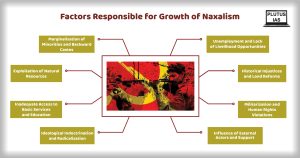31 Jul Left Wing Extremism (LWE)
This article covers “Daily Current Affairs” and the topic details “Left Wing Extremism (LWE)”. The topic “Left Wing Extremism (LWE)” has relevance in the Internal Security section of the UPSC CSE exam.
For Prelims:
Definition of Left Wing Extremism (LWE)?
Most affected areas?
Objectives of Sacred Portal?
For Mains:
GS 3: Internal Security
Factors Responsible for LWE?
Government Initiatives?
Way Forward?
Why in the news?
In a recent announcement, the Ministry for Home Affairs disclosed its decision to maintain distinct data for incidents related to Left Wing Extremists (LWE) in India, beginning from the year 2022.
Definition and Nature:
- Left Wing Extremism, also known as left-wing terrorism or radical left-wing movements, is a form of political extremism rooted in leftist ideologies.
- LWE groups seek significant social, economic, and political changes, often advocating for a classless society or socialist/communist principles.
- They believe in achieving their goals through revolutionary means, including armed struggle and violence.
Origin in India:
- The LWE movement in India originated in the late 1960s with the Naxalbari uprising in Naxalbari, West Bengal.
- Inspired by Maoist ideologies, the movement sought to address issues of landlessness, exploitation of peasants, and socioeconomic disparities.
Activities and Targets:
- LWE groups engage in various activities, including armed attacks, bombings, assassinations, and sabotage.
- They target government institutions, law enforcement agencies, infrastructure, private property, and individuals they perceive as oppressors or impediments to their goals.
The most affected areas include:
- Chhattisgarh: LWE has a significant presence in the southern and eastern parts of Chhattisgarh, particularly in districts like Bastar, Sukma, Bijapur, and Dantewada.
- Jharkhand: The state has been grappling with LWE in various districts, including Latehar, Palamu, Gumla, and Simdega.
- Odisha: LWE activities have been reported in some districts of Odisha, especially in areas bordering Chhattisgarh and Andhra Pradesh.
- Bihar: Certain districts in Bihar, like Gaya, Aurangabad, and Jamui, have witnessed LWE-related incidents.
- Andhra Pradesh and Telangana: While the movement has seen a decline in these states, some areas on their border with Chhattisgarh still face LWE challenges.
- Maharashtra: Gadchiroli district in Maharashtra has been affected by LWE activities.
- West Bengal: Although the Naxalite movement had its origin in Naxalbari, West Bengal, the state has seen a decline in LWE activities in recent years.
Responsible Factors for LWE:
- Socio-economic Disparities: Large sections of the population living in poverty, lack of access to basic amenities, and unemployment contribute to grievances exploited by LWE groups.
- Land Alienation and Displacement: Land rights and acquisition issues, particularly in tribal areas, have led to displacement and resentment, providing a breeding ground for LWE.
- Lack of Adivasi Rights: Exploitation of natural resources in tribal regions and marginalization of Adivasis have been focal points of LWE agitation.
- Governance Gaps: Inadequate governance, corruption, and lack of effective administration in affected regions have facilitated LWE growth.

Government Initiatives:
- National Policy and Action Plan to Address LWE 2015:
- A comprehensive approach involving governance, security, and development to counter LWE.
- Focused on improving security measures, safeguarding rights of local communities, and promoting socio-economic development.
- Integrated Action Plan (IAP):
- Introduced in 2010 to accelerate development in 82 LWE-affected districts.
- Aimed at bridging development gaps and addressing grievances.
- Security Operations:Security forces undertake operations to neutralize LWE groups and leaders, ensuring law and order.
- Surrender and Rehabilitation Policy:
- Encourages LWE cadres to surrender and integrate into mainstream society.
- Provides rehabilitation and skill development opportunities.
Way Forward:
- Strengthening governance and administration in affected areas.
- Implementing sustainable development projects and land reforms.
- Addressing socio-economic disparities and ensuring inclusive growth.
- Fostering dialogue and reconciliation with disaffected groups.
- Combining security measures with development initiatives to root out extremism.
Q.1 Which of the following states in India have been affected by Left Wing Extremism (LWE) activities?
- Karnataka
- Jharkhand
- Maharashtra
- Punjab
Select the correct option(s) from the choices given below:
(a) 1 , 2 and 4 only
(b) 1 and 3 only
(c) 2 and 3 only
(d) 1, 2, 3 and 4
Answer:(c)
Q.2 Which of the following statements about Left Wing Extremism (LWE) in India is/are correct?
- LWE is a form of political extremism rooted in right-wing ideologies, seeking significant social and political changes through revolutionary means.
- The LWE movement in India originated in the late 1960s with the Naxalbari uprising in Naxalbari, West Bengal.
- LWE groups in India primarily target government institutions, law enforcement agencies, and individuals perceived as oppressors.
Select the correct option:
(a) 1 and 2 only
(b) 1 and 3 only
(c) 2 and 3 only
(d) 1, 2 and 3
Answer: (c)



No Comments